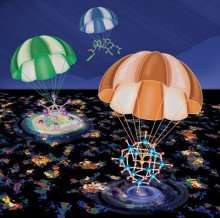Researchers apply ion soft-landing technique for advances in materials synthesis

Today's demanding applications in chemical manufacturing, energy generation and storage, pollution abatement, and health care are driving development of new materials with catalytic and optoelectronic functionalities. However, to predict and control the properties of such materials, scientists have been studying their development process at a molecular level. Frequently, a detailed understanding is impeded by the presence of a complex and poorly defined soup of spectator molecules that complicate interpretation of experimental results and make high-level theoretical modeling difficult.
To highlight a novel approach to overcoming this challenge, scientists at Pacific Northwest National Laboratory (PNNL) and Purdue University teamed to review the ion soft-landing technique and its application to materials synthesis. Using this technique to gently place selected molecules onto surfaces lets scientists maintain exquisite control over the molecular ingredients that make up complex materials.
The effort was recently included in an invited review article featured in Angewandte Chemie International Edition titled "From Isolated Ions to Multilayer Functional Materials Using Ion Soft-Landing."
In the review article, Julia Laskin, Grant Johnson, Jonas Warneke, and Venkateshkumar "Venky" Prabhakaran describe the approach and benefits of the ion soft-landing technique. For example, such precise control is achieved by first converting molecules into ions, which are easy to manipulate using electric and magnetic fields. The ions are then accurately sorted by their composition and ionic charge state and delivered as a concentrated beam of known shape and size to a surface to prepare tailored films and nanostructures. The resulting materials have predetermined compositions, which makes their measured physical properties and chemical reactivity easier to attribute to specific geometric and electronic features observed experimentally. This, in turn, enables theoretical modeling and a predictive—as opposed to a trial-and-error—approach to material design.
"Ion soft-landing allows scientists to precisely control the composition and coverage of a wide range of molecules including non-volatile species that are otherwise difficult to deposit," said Johnson, a physical chemist at PNNL. Johnson mentioned that the technique may also be used to generate novel clusters and nanoparticles using energetic sputtering-based techniques as well as highly reactive intermediates that cannot be produced using conventional methods.
These scientists were invited to write the review because of their leading roles in developing the technique for studies in energy storage, materials synthesis, and catalysis and their substantial contributions to the wider field of ion-surface interactions.
"We've been fascinated by the ion soft-landing technique for more than a decade," said Laskin, a chemistry professor at Purdue University. "Over the years, we've established both the experimental capabilities and understanding of key phenomena that are necessary to develop it into a powerful approach for materials synthesis."
Understanding structure-property relationships is essential to designing improved materials for future applications. Such understanding allows researchers to avoid the labor-intensive, time-consuming, and costly trial-and-error experiments that are otherwise necessary to explore how different parameters influence the properties and performance of new materials. Structure-property relationships are challenging to extract from complex mixtures where the presence of other inactive compounds obscure the analytical response of molecules of interest. The ion soft-landing technique creates well-defined, high-value materials such as tiny metal and metal oxide particles of exact size and composition for studies in heterogeneous catalysis and electrochemical energy storage (e.g., supercapacitors and batteries).
Researchers from Pacific Northwest National Laboratory and Purdue University—Julia Laskin, Grant Johnson, Jonas Warneke, and Venkateshkumar "Venky" Prabhakaran—were invited to prepare a review article based on their years of experience developing the ion soft-landing technique for studies in energy storage, materials synthesis, and catalysis. The team, positioned and determined to continue advancing the ion soft-landing technique into a unique approach for materials synthesis, selected the contents of the review after perusing hundreds of articles from scientists and colleagues at national laboratories and universities around the globe.
Their review article in Angewandte Chemie International Edition—a Journal of the Gesellshaft Deutscher Chemiker—emphasized recent developments in ambient soft-landing, which allow certain advantages of ion soft-landing in vacuum to be reproduced on the laboratory benchtop at reduced expense and complexity.
Prabhakaran, a materials scientist at PNNL, said that the team found that "high-flux vacuum-based soft-landing combined with in situ electrochemical characterization constitutes a versatile approach for understanding the role of different active components on the performance of energy storage devices."
In addition, the team found that the technique can provide insight into how the properties of molecular ions at high coverages may be used to tailor the initial morphology and structural evolution of condensed-phase films.
"We used high-flux ion soft-landing to generate fascinating liquid-like layers on surfaces for the first time," said Warneke, a Humboldt Postdoctoral Fellow who came to PNNL from Germany specifically to pursue research in ion soft-landing. Warneke stated that "it is an ideal tool for investigating the emergent properties of layers containing large numbers of clusters and complex molecules, which may open up new vistas in energy science and other disciplines."
The next step for ion soft-landing research is to control the three-dimensional arrangement of macroscopic structures formed through mass-selected ion deposition. This advancement will allow the properties of ion-based materials to be tailored with even finer precision.
More information: Julia Laskin et al. From Isolated Ions to Multilayer Functional Materials Using Ion Soft-Landing, Angewandte Chemie International Edition (2018). DOI: 10.1002/anie.201712296
Journal information: Angewandte Chemie International Edition
Provided by Environmental Molecular Sciences Laboratory




















